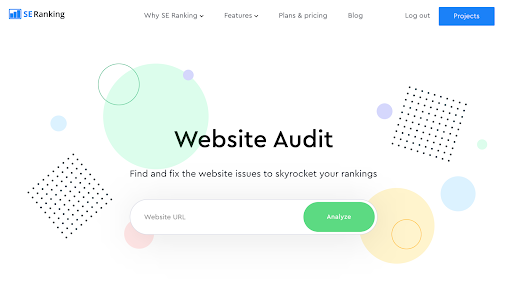In 2023, online retailers sold products for a total of 4.28 trillion US dollars, and this number is projected to grow up to 5.4 trillion US dollars in 2022.
Table of Contents
The role of SEO in generating these revenues is difficult to estimate because online retailers get about 33% of site visits from organic search results.
You definitely want to get a share of organic traffic from search engines for yourself. However, this requires investing in SEO and monitoring its progress.
The scope of SEO work is vast and involves content optimization, making your site crawlable and indexable by search engines, and ensuring a good user experience. These things require a lot of technical optimization.
Technical SEO deals with small and countless issues scattered across thousands of pages. If overlooked, they can significantly undermine your site’s rankings. How do you keep tabs on everything? An automated website audit can help you out.
Why Is Website Audit Important for eCommerce Sites
eCommerce SEO is hard because of the harsh competition from huge marketplaces. It doesn’t promise quick wins and requires making small and incremental changes to gradually improve your site’s positions. It’s about optimizing thousands of tiny little things and avoiding missteps.
The easiest way of knowing what is worth optimization is to run an automatic website SEO audit. You’ll need a tool that will crawl your site on schedule, check it against all possible technical SEO issues, and provide you with a comprehensive report.
Common eCommerce Sites Technical Issues
There are heaps of technical SEO problems typical for online stores. Some of these issues are caused by peculiarities in the structure and navigation of eCommerce websites. Others stem from the nature of the retail business itself. Regardless of their origin, you can spot them using a website audit tool.
Unique metadata for thousands of pages
For an online store, you can’t manually create unique titles and descriptions for every single product page if there are thousands of them.
You’ll have to automate this task. Yet, refrain from using similar titles and descriptions for many pages. Instead, create a unique template for each category, subcategory, brand, etc., and use automation to insert variables into the templates.
Wrong pages crawled and indexed
Online shops have a lot of pages that shouldn’t be indexed by search engines because they either contain sensitive data or don’t provide value to users in search results.
Although, if you don’t implement proper restrictions for crawlers, your thank-you pages, shopping cart pages, contact forms, and so on, may end up in the index. To avoid that, you should use restrictive directives in the robot’s meta tag and X-Robots-Tag correctly.
Parameterized URLs with duplicate content
Your customers want to use site search, files, and sorting to quickly find items in your catalog. Although these tools improve user experience, they can create tons of parameterized URLs that contain similar lists of products.
As a result, many pages with duplicate content will compete in search results. To fix that, you should block parameter versions of each page from indexing and insert the rel=”canonical” link tag in them to point to the original page to be indexed.
404 pages for out-of-stock products
Some items go out of stock, while others go out of fashion. Whatever the case, you have to get rid of the pages for products you don’t sell anymore. By doing so, you might create a bunch of 404 pages.
They’ll waste your site’s crawling budget, cause broken links on other pages of your site, and spoil your site’s link equity if any external resources link to them. To minimize the harm, you should redirect the missing product pages to relevant category pages.
Slow load speed and poor core web vitals
Your online shop may have a fancy design, high-quality photos of products, interactive features, and a dynamic interface. All that beauty can be a double-edged sword if it comes at the cost of page speed.
If your pages load slowly, you should leverage file compression, caching, and various code optimization techniques to improve your site’s performance.
Each of the above-mentioned issues can appear due to technical errors or human factors when you set up a new site or make changes to the old one. They can affect a huge number of pages and are hard to find manually.
Let’s look at how you can quickly spot them using SEO software. We’ll use the SE Ranking Website Audit tool to automatically crawl a site and quickly get a comprehensive report of possible technical SEO issues.
Start eCommerce Website Audit with SE Ranking
To check your site, type its URL in the search bar of the SE Ranking Website Audit tool. Alternatively, you can sign up for the platform and have the audit launched automatically after you create an account.
Either way, the tool will check your site against 110 SEO parameters. In a couple of minutes, you’ll get a comprehensive report that will include an overview of your site’s health, a detailed report on every issue, and complete lists of all the crawled pages, resources, and links.
This data will be available in the Website Audit module of the SE Ranking platform. Now let’s go through the Issue Report and look at what you’ll find there.
Crawling Issues. This section includes reports on 17 issues that concern sitemap.xml, robots.txt, robots meta tag, X-Robots-tag, HTML, and HTTP headers that may contain directions for search engine bots on how to navigate, crawl, and index your pages.
For example, on the screenshot above, you can see that nike.com is missing a sitemap.xml file. If you have a similar issue, you can create the file right from the Issue Report by clicking the Generate Sitemap button above the table.
Duplicate content. In this section of the report, you’ll find 5 possible issues that can cause page duplication. These may be either technical flaws, like missing server redirects for URLs with www, double or trailing slashes, or the use of similar content across many pages. In the table, you’ll be able to open the full list of affected pages by clicking the number of affected pages.
HTTP Status Code. This section will allow you to handle all the pages that currently have 3XX, 4XX, and 5XX statuses. If your site has undesirable cases such as 404 canonical URLs or pages with redirects listed in your XML sitemap (the total of 22 different issues), they will all be flagged and listed here.
Title, Description, and Textual Content. To check if any pages have problems with missing, duplicate, or empty metadata and H1-H2 headings, check these three sections of the report. In no time you’ll see the list of problematic pages available for you to export from the table in a .xls or .csv format.
Internal and External Links. These two sections of the report will have you covered if you need to find pages that contain nofollow links or ones that miss a meaningful anchor.
You’ll also see if any of your pages are spammed with links (contain more than 400 of them) or don’t have any links pointing to them from other pages of your site (so-called orphan pages). This will help you better distribute your PageRank weight across pages and rank higher on Google and other engines.
Website Speed, Mobile Optimization, and Performance. The issue report has a bunch of sections that will help you detect user experience issues.
You’ll be able to find information on Core Web Vitals and a dozen of other site performance metrics. None of the issues slowing down your website will go unnoticed.
If it’s difficult for you to grasp what all these metrics mean, feel free to download the report and forward it right to your developers.
These are some examples of issues that you can detect using a website audit tool. The Issue Report in SE Ranking is definitely worth taking a deeper look at.
All you need to do to have your site analyzed across every possible aspect of technical SEO is type its URL in the tool. Happy SEO bugs hunting!
Takeaway
A technical website audit can point you to the issues that deserve your attention and give you a list of affected pages within minutes. You’ll know what to fix next to boost your SEO and can assign a task to your developer, writer, content manager, or yourself.
There’s one more cool thing about these reports. Not only will you know that your website has some issues, but you’ll also get practical tips on how to fix them.
Even if you have no idea what a certain issue is about, just click on its title and you’ll get its description and a short guide on how you can fix it.




